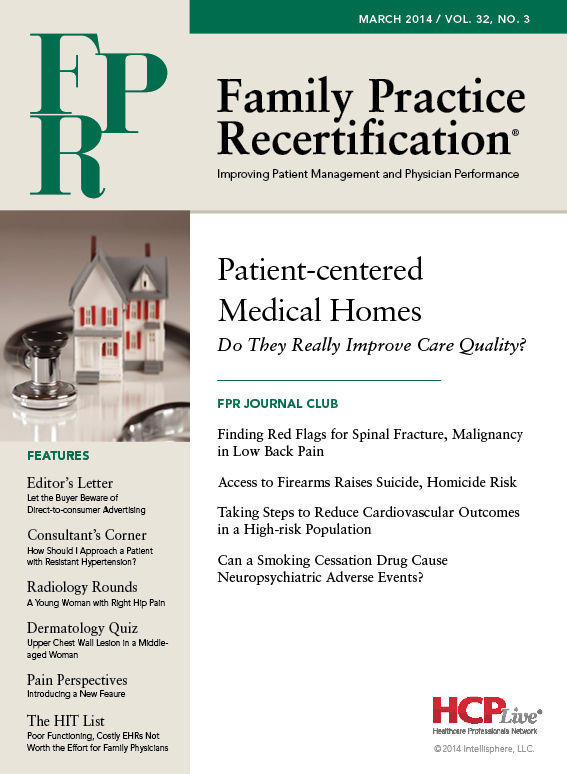Publication
Article
Family Practice Recertification
Taking Steps to Reduce Cardiovascular Outcomes in a High-risk Population
Author(s):
Family physicians should place as great an emphasis on walking as they do on monitoring medication and laboratory data, and strongly recommend increased ambulatory activity to their patients.
Review
Yates, T, et al. Association between change in daily ambulatory activity and cardiovascular events in people with impaired glucose tolerance (NAVIGATOR trial): a cohort analysis. Lancet. 2013 Dec 20. http://www.thelancet.com/journals/lancet/article/PIIS0140-6736(13)62061-9/fulltext.
Study Methods
This was a prospective cohort study of 9,306 individuals from NAVIGATOR, a worldwide, multicenter, randomized, placebo-controlled trial designed to determine whether valsartan and nateglinide are successful in preventing cardiovascular (CV) complications in patients with impaired glucose tolerance.
As part of the study, ambulatory activity was measured through self-report and calculated as the average number of steps taken per day. Change in ambulatory activity was assessed by the difference in the average number of steps measured throughout the trial, compared to the initial recording. This data was used to estimate the association between change in ambulatory activity and the risk of a subsequent CV event. Participants were followed-up for an average of 6 years for CV events, including non-fatal stroke, myocardial infarction (MI), and death from CV causes.
Patient Demographics
All participants had impaired glucose tolerance and either existing cardiovascular disease (CVD) if aged ≥50 years or at least 1 additional CV risk factor if aged ≥55 years. The average participant age was 63 years old and women made up 51% of the study population.
Intervention and Control
Each subject was given the same lifestyle instructions and interventions. The participants acted as self-controls for the analysis of the change in their ambulatory activity over the 12 months. They also enrolled in a lifestyle modification program designed to help them achieve and maintain a 5% weight loss, reduce the amount of saturated and total fat in their diet, and increase their physical activity to 150 minutes a week. The program was reinforced 7 times over the next 12 months, with additional phone call reminders.
Two weeks after baseline clinical measurements were taken, participants were supplied a pedometer and instructed to wear it during waking hours for 7 consecutive days. Ambulatory levels were measured at baseline and then reassessed at 12 months. The subjects were then divided into groups based on their initial ambulatory readings and change in their step activity.
Results and Outcomes
The primary endpoint was a composite of MI, stroke, and death from CV causes, which was analyzed as a hazards ratio (HR) between baseline ambulatory steps and change in ambulatory activity over the 12-month period, though CV events were tracked for up to 6 years.
Both starting level and change in ambulatory activity were independently and inversely associated with an increased risk of CV events. In other words, the greater the patients’ baseline activity or increase in steps, the lower their risk of experiencing a CV event.
At baseline, each increment of 2,000 steps per day was associated with a 10% lower CV event rate. Following the intervention, every 2,000-step increment increase from baseline was associated with an additional 8% lower CV event rate. Additionally, a decrease of 2,000 steps per day was associated with a significant increase in risk.
These results were unaffected when further adjusted for change in body mass index (BMI) and estimated glomerular filtration rate, as well as the occurrence of unstable angina between baseline and 12 months.
Conclusion
Both baseline level and change in ambulatory activity over 12 months were independently associated with the risk of a CV event in the ensuing 5 years. At baseline, a higher degree of ambulatory activity was associated with a lower risk of a CV event. Each additional 2,000 steps per day over baseline were associated with an additional 8% difference in the CV event rate. These findings support the promotion of increased ambulatory activity in patients with impaired glucose tolerance plus multiple CV risk factors, and the avoidance of decreased ambulatory activity irrespective of the starting level.
Commentary
This study, which was funded by Novartis, was designed to analyze a medication intervention primarily and a lifestyle modification program secondarily. The paper focused on the effect ambulatory activity has on CV event risk for patients who have impaired glucose tolerance. In the primary study, neither drug provided benefit at preventing diabetes or CV events.
The limitations of this study included its design as a drug intervention trial, rather than a sole evaluation of a non-blinded lifestyle intervention. Other limitations involved dependence on patient reporting of pedometer results and limited follow-up . Lastly, baseline CV fitness was not measured, so there may have been a subset of highly fit patients whose fitness skewed the outcomes. Each of these variables could have led to study bias.
Despite its limitations, the study provides convincing evidence that increasing ambulatory activity in high-risk patients with impaired glucose tolerance will reduce their risk of having a CV event. It also presents evidence that a reduction in baseline activity level could increase the risk of CV events in those patients.
Both of these findings should encourage family physicians to emphasize daily activity in their patients with glucose intolerance and high CV risk or history of CV events. The data makes a strong case for encouraging increased physical activity in at-risk patients and the use of modalities like cardiac rehabilitation and walking programs.
Since the scope of this trial was limited by its design as an observational study, causation could not be gleamed from the data. However, the results provided compelling support for a simple non-pharmacologic intervention that lowers cardiac risk in a high-risk population. Family physicians should place as great an emphasis on walking as they do on monitoring medication and laboratory data, and strongly recommend increased ambulatory activity to their patients.
About the Authors
Benjamin Bier, MS IV, is a medical student at the University of Massachusetts Medical School in Worcester, MA.
He was assisted in writing this article by Frank J. Domino, MD, Professor and Pre-Doctoral Education Director for the Department of Family Medicine and Community Health at the University of Massachusetts Medical School and Editor-in-Chief of the 5-Minute Clinical Consult series (Lippincott Williams & Wilkins).





